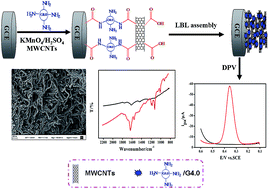An electrochemical paracetamol sensor based on layer-by-layer covalent attachment of MWCNTs and a G4.0 PAMAM modified GCE†
Abstract
An electrochemical sensor for the detection of paracetamol (PAT) was reported employing multiwalled carbon nanotubes (MWCNTs) and the fourth generation poly(amidoamine) dendrimers (G4.0 PAMAM). The strategy of this work lies on the formation of a stable covalent linkage between carboxylated MWCNTs and amine terminated G4.0 PAMAM via covalent layer-by-layer (LbL) self-assembly, which provides larger surface areas for efficient adsorption of PAT. The constructed electrode was characterized first by Fourier transform infrared spectroscopy and scanning electron microscopy, and then the electrochemical behavior of PAT on the (MWCNTs–G4.0)6/GCE was investigated in detail by cyclic voltammetry, electrochemical impedance spectroscopy and chronocoulometry. Under optimal conditions, the experimental results demonstrated that the constructed sensor exhibited excellent catalytic activity toward PAT, and a wide linear range from 3.0 × 10−7 to 2.0 × 10−4 M was obtained with a limit of detection (LOD) of 1.0 × 10−7 M (S/N = 3). Moreover, it could also be applied to the determination of PAT in commercial tablets and human serum, and the satisfactory results confirm the applicability of this sensor in practical analysis.


 Please wait while we load your content...
Please wait while we load your content...